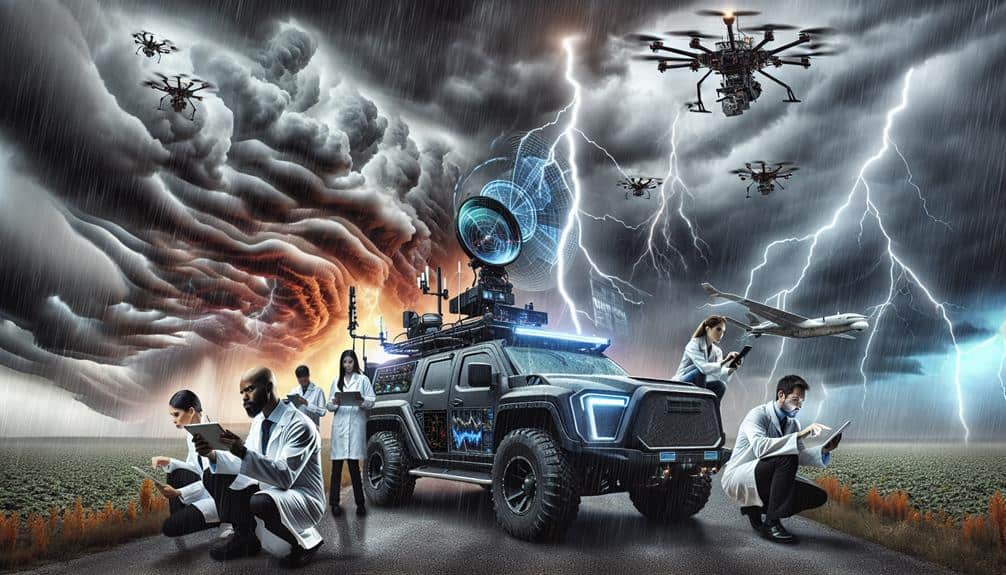Interpreting atmospheric data is essential for us as storm chasers because it allows for accurate predictions of severe weather events by analyzing key parameters like temperature, humidity, wind speed, and atmospheric pressure. We rely on advanced meteorological tools and real-time data from satellites, weather stations, and radars to assess potential threats. This real-time analysis informs our immediate decisions on positioning and safety measures, enhancing both our forecasting accuracy and response strategies. By identifying storm patterns and making data-driven adjustments, we can anticipate shifts in storm behavior, ensuring we're well-prepared for any situation. More insights on these methods await.
Key Points
- Atmospheric data interpretation allows storm chasers to anticipate severe weather events accurately, enhancing safety and effectiveness.
- Real-time data analysis provides crucial insights for positioning and tracking storms dynamically.
- Identifying atmospheric anomalies helps in predicting storm formation and potential severity.
- Continuous monitoring of temperature, wind speed, and pressure aids in making informed decisions during storm chasing missions.
Predicting Severe Weather
Accurate prediction of severe weather hinges on the meticulous analysis of various atmospheric parameters such as temperature, humidity, wind speed, and pressure. We can't overstate the importance of data interpretation in storm prediction.
By analyzing these parameters, we can identify patterns and anomalies that signal the potential for severe weather events like tornadoes, hurricanes, and thunderstorms.
Using advanced meteorological tools and models, we process vast amounts of data from satellites, weather stations, and radar systems. This data is then fed into algorithms that help us create predictive models. These models use historical data to refine their accuracy, allowing us to forecast severe weather with greater precision.
For instance, sudden drops in atmospheric pressure and rapid shifts in wind speed are critical indicators of storm formation.
Enhancing Safety Measures
To enhance safety measures, we analyze real-time atmospheric data to develop and implement proactive strategies that mitigate the risks associated with severe weather events. By continuously monitoring parameters like wind speed, humidity, and temperature gradients, we perform thorough risk assessments that allow us to anticipate potential hazards.
This data-driven approach lets us make informed decisions on where to position ourselves and when to evacuate, ensuring that we stay out of harm's way while gathering critical information.
Our emergency response protocols are built on the foundation of this real-time data. We use advanced algorithms to predict the speed and direction of storm systems, giving us the lead time needed to execute evacuation plans effectively.
Coordination with local authorities and other storm chasers is streamlined through shared data platforms, enhancing our collective ability to respond swiftly to emerging threats.
Improving Forecast Accuracy
Leveraging real-time atmospheric data not only bolsters our safety measures but also enhances the precision of our storm forecasts. By interpreting this data accurately, we can make pivotal decisions based on the latest meteorological advancements. These advancements allow us to refine our predictive models, resulting in more precise and timely forecasts.
When we analyze atmospheric data, we're not just looking at numbers; we're interpreting intricate patterns that indicate potential storm development. This data interpretation involves examining variables such as temperature, humidity, wind speed, and atmospheric pressure. By integrating these variables into our models, we can predict storm paths with greater accuracy and warn communities in advance.
Moreover, advancements in meteorological technology, like Doppler radar and satellite imagery, provide us with high-resolution data that was previously unavailable. Utilizing this data, we can detect subtle changes in storm behavior and adjust our forecasts accordingly. This level of precision is essential, especially when time-sensitive decisions are needed to protect lives and property.
In essence, our ability to interpret and act on real-time atmospheric data directly impacts the accuracy of our storm forecasts. Improved forecast accuracy empowers us to make informed decisions, offering a greater sense of freedom and security for all.
Real-Time Data Utilization
By tapping into real-time atmospheric information, we can dynamically adjust our storm tracking and prediction models with unparalleled precision. Utilizing advanced technology, we access a continuous stream of meteorological details, which allows us to perform immediate data analysis, enhancing our situational awareness.
The integration of cutting-edge sensors, satellite imagery, and Doppler radar systems provides a robust framework for ingesting and processing vast amounts of data in real time.
Our ability to leverage these technology advancements means we can identify rapid changes in storm behavior and structure, making real-time adjustments to our trajectories and safety protocols. This agility is vital, as it empowers us to navigate the complexities of severe weather systems with greater confidence and accuracy.
Moreover, real-time data utilization supports collaborative efforts among storm chasers, meteorologists, and emergency services. By sharing live updates and findings, we contribute to a collective understanding that can improve public safety and preparedness.
In essence, the capacity to harness real-time atmospheric data transforms our approach, allowing us to make informed, split-second decisions. This capability not only enhances our operational effectiveness but also aligns with our core desire for freedom and precision in the pursuit of storm chasing.
Identifying Storm Patterns

Understanding storm patterns requires a vital analysis of atmospheric data to identify recurring behaviors and anomalies. We rely on storm tracking and meteorological analysis to predict where and when severe weather will strike. By examining long-term weather observation records, we can discern patterns that signify potential storm genesis. This involves scrutinizing data points such as temperature, humidity, wind speed, and pressure changes.
Our atmospheric interpretation skills enable us to detect early signs of storm development. We look for specific indicators like supercell formations, which are often heralded by specific atmospheric conditions. By analyzing radar and satellite imagery, we can visualize storm structures and track their evolution in real-time. This process isn't just about understanding existing weather conditions but also predicting future movements and intensities.
Incorporating advanced meteorological tools enhances our ability to identify these patterns. For instance, Doppler radar helps us measure wind velocity within a storm, while satellite data provides a broader view of storm systems. These tools, combined with our analytical expertise, allow us to make informed decisions about storm chases.
Ultimately, identifying storm patterns is a pivotal step in our mission to understand and anticipate severe weather, ensuring we harness the freedom to chase safely and effectively.
Frequently Asked Questions
What Types of Instruments Do Storm Chasers Use to Collect Atmospheric Data?
Storm chasers use Doppler radar, anemometers, and barometers. These devices demand diligent data analysis and instrument calibration. Accurate forecasts from precise weather modeling enhance our ability to predict storms, ensuring we follow freedom's pursuit with scientific precision.
How Do Storm Chasers Communicate With Each Other During a Chase?
We use various communication methods like radios and smartphones to promote seamless teamwork during chases. Employing advanced technology and strategies, we coordinate our positions and share real-time data, maximizing efficiency and safety in unpredictable conditions.
What Training Is Required to Become a Professional Storm Chaser?
We need a solid meteorological education and extensive field experience to become professional storm chasers. This training helps us analyze data accurately, anticipate storm behavior, and make informed decisions, ensuring both our safety and freedom in the field.
How Do Storm Chasers Fund Their Expeditions and Equipment?
We fund our expeditions through a mix of funding sources, including sponsorship deals and donations. Equipment costs are high, but these financial supports allow us to maintain and upgrade our tools for accurate, real-time data collection.
What Are the Ethical Considerations in Storm Chasing?
We must consider ethical aspects like adhering to safety protocols and minimizing environmental impact. Ensuring our actions don't harm local communities or ecosystems is vital while balancing personal freedom with responsible storm chasing practices.


